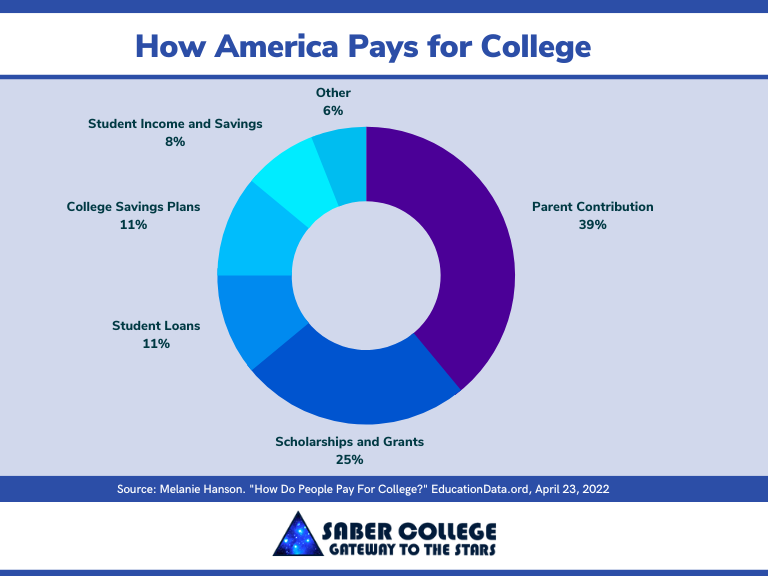
How to Pay for College. Untapped Strategies and Resources
Choosing to go to college can be an exciting and life-changing decision. However, figuring out how to pay for college can be just as life-changing. The possibilities of what you can do with your degree may be endless. Your financial future will be in your hands, and finding a safe and effective way to manage how to pay for college is probably just as important as the degree itself.
There are many options, such as federal student loans, scholarships, grants, and other programs students don't know about. Talk to your college's financial aid office or speak with someone in the school's veteran organization. If you're looking for ways to fund your Physical Therapist Assistant or Registered Nurse Education, you should consider the following options.

529 College Savings Plan
Paying for college can be tricky and may require planning with your personal finances. There are many different ways to pay for it, and each has its pros and cons, including the 529 plan.
A safe way to pay for college is by using a 529 college savings plan, which is tax-free. A 529 plan lets you invest money in a particular savings account that grows tax-free until you withdraw it—and even then, there are no taxes on your withdrawals as long as they go toward paying for qualified educational expenses. You can open up a 529 plan with any state or local government or agency, though your state may offer special benefits if you use their plan.
There are two types of 529 plans: prepaid tuition and savings plans. Prepaid tuition plans let you lock in current college costs at an in-state public university so that when it comes time for your child—or grandchild!—to attend school, they'll have enough money saved up to do so without having to take out student loans or other forms of debt. 529 plans let you invest money into stocks and bonds to grow your investment over time so that when the time comes, it will be enough.
Local Scholarships
Many colleges offer local scholarships to cover tuition and fees for students who live in their area. You might not think that applies to you, but it may.
The best way to find out if your school offers local scholarships is by visiting their website and looking through their scholarship section. If they don't have a scholarship section on their website, try searching Google or another search engine for "[college name] scholarships." If nothing comes up right away, try using "[college name] scholarships" plus the word "local" or "nearby."
Many schools will have listings for awards only within a certain distance from campus. These awards can range from $200 to $1,000 and may require an essay or application process. Many scholarships are awarded based on merit (such as GPA) or financial need—these awards tend to be larger than those awarded based on scholarship requirements alone.
The scholarship(s) may not be enough to cover your full tuition and fees as a college student, so securing a part-time job may help ease any burden on your personal finances.
Financial Aid Appeals
If you're a college student looking to become one, you've probably heard the term "financial aid appeals" thrown around. But what exactly is it, and is it the answer to “how to pay for college”?
Let's start by defining what financial aid appeals are. Financial aid appeals request additional funding from your school's financial aid office. They can be made in response to a denial or reduction of federal or state aid or when the student has experienced a change in income, family size, or dependency status since filling out the FAFSA (Free Application for Federal Student Aid).
But just because you've been denied doesn't mean you should give up hope—there are several ways to appeal your financial aid award based on different circumstances. Here are some tips on how to approach appealing your financial aid award:
Income Changes - If your family income has changed since you filed your FAFSA and it has resulted in an increase in expected family contribution (EFC), contact your school’s financial aid office immediately! The sooner they know about the change, the more likely they will be able to adjust their calculations accordingly. Explain if the increase was due to a job loss or other unexpected circumstances.
No-Loan schools
What if we told you there was a way to go to school without taking out loans?
That's precisely what's possible. But what does it mean in terms of how to pay for college? It means there are school options that financial aid offices do not use federal government loans, institutional loans, or private student loans to help you meet your college costs. Instead, they cover the debt with scholarships, grants, work-study opportunities, and contributions when possible.
Employer Tuition Assistance
One of the best ways to pay for college is by using your employer's tuition assistance.
Many companies offer this benefit as part of their benefits package. Your employer's tuition assistance policy will vary from company to company, so be sure to ask about it before applying for a school.
If you are lucky enough to have access to an employer-sponsored tuition assistance program, here's what you need to know:
Your employer may offer a variety of tuition assistance options. Some companies will pay 100% of your tuition and fees, while others only cover a portion. You may also be able to receive cash payments or reimbursements that can be used toward any educational costs, such as books, student fees, and other related expenses.
If you have more than one option available through your employer's tuition assistance program, it's important that you understand how each type works before making any decisions about which one fits best with your educational goals. For example, if your company offers a reimbursement plan but only provides $1,000 per term instead of paying directly toward tuition costs, then this may not be enough money for all four years at an expensive private university. You may need to look into a community college or something more budget-friendly.
Advanced Placement and Dual-Enrollment Credits
If you take advanced placement courses, you might be able to earn college credit. You can then use the credits toward your degree requirements.
Some colleges will pay for these courses or offer scholarships and financial aid to students who take them. If a college doesn't pay for them, it may still let you use the credits toward your degree requirements. This means that you won't have to take as many of these classes during college and may be able to graduate faster.
Prior Learning Assessments
You might be wondering, “What Are Prior Learning Assessments?”
PLAs are what they sound like—they're tests that show how much knowledge you have about a given subject or discipline. They can be used in conjunction with other forms of assessments, like an academic transcript or portfolio, to prove that you already have a certain amount of knowledge about a particular subject area.
This can help you get credit for your classes in school, online, or at a local community college.
PLAs can also give you credit for work experience outside of traditional education settings—like if you worked on an internship over the summer or did an apprenticeship program. This could mean more money saved on tuition costs!
ROTC Programs
ROTC programs offer free tuition and other benefits to eligible students who agree to participate in their training program after graduation. These programs are available in many military branches, including the Army ROTC, Navy ROTC, Air Force ROTC, Marine Corps ROTC, and Coast Guard ROTC.
While many ROTC programs are available at colleges across the country, most involve military training while enrolled at an accredited university or college. This means that students will be required to attend classes on campus and participate in physical training activities during their free time outside of class hours. In exchange for this commitment, students receive free tuition and other valuable benefits such as textbooks or supplies.
Additionally, since these programs are funded through government grants rather than private donations or tuition payments from individual students or schools, they tend to have lower costs than other forms of financial aid.
Regional Tuition Exchange Programs
Regional tuition exchange programs are agreements between educational institutions in different states to allow students to attend classes at an institution in another state without paying out-of-state tuition. These programs have been around since the early 1900s, but they've grown significantly since then. There are now more than 80 regional tuition exchange programs across the country!
Public schools usually make agreements, but some private universities also participate. The agreements allow students to attend classes at other institutions without paying their home state's out-of-state tuition rate. Some colleges even offer lower tuition rates for in-state residents who choose to take courses through regional tuition exchange programs.
Continuing your education may help you learn new skills, develop new passions, and improve your life. And though it can be expensive, many options are available to help you pay for the cost of college. We hope this guide will help you find the right one for you.

